Time Loops
Understanding Time Laws and Time Loops
Introduction
Time is a fascinating concept that has intrigued philosophers, scientists, and storytellers for centuries. In this article, we will delve into the intriguing topics of time laws and time loops, exploring their significance and implications.
Time Laws
Time laws are fundamental principles that govern the passage of time in our universe. These laws dictate the direction of time, stating that it moves only in one direction - from the past, through the present, and into the future. One of the most well-known time laws is the Second Law of Thermodynamics, which states that the entropy of a closed system tends to increase over time.
Key Concepts:
- Causality: The principle that causes precede effects, establishing a clear sequence of events.
- Time Dilation: The stretching or shrinking of time intervals as described by the theory of relativity.
- Arrow of Time: The asymmetrical nature of time, moving from order to disorder.
Time Loops
Time loops are a popular trope in science fiction where a certain period of time repeats itself, creating a loop. This concept often leads to paradoxes and questions about free will and determinism. While time loops are a fascinating narrative device, they challenge our understanding of causality and the linearity of time.
Examples in Popular Culture:
- Groundhog Day: A film where the protagonist relives the same day repeatedly.
- Looper: A movie involving time travel and self-fulfilling prophecies.
Conclusion
Time laws and time loops offer us a glimpse into the complexities of time and the universe. While time laws govern the natural flow of time, time loops challenge our perception of cause and effect. By exploring these concepts, we can deepen our appreciation for the enigmatic nature of time and the mysteries it holds.


